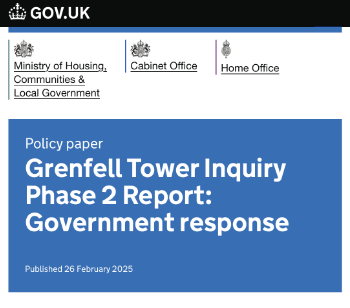Partial possession of the site by the client
As construction nears completion, there can be considerable pressure to allow the client or tenants to take possession of part of a building or site, even if the works are ongoing or there are defects that have not been rectified.
This can be programmed as part of the works through a requirement for sectional completion, but in the absence of such a provision many contracts offer the more open-ended option of partial possession.
The effect of partial possession is that:
- Any part for which partial possession is given is deemed to have achieved practical completion.
- Half of the retention for that part must be released.
- The defects liability period (or rectification period) begins for that part.
- Liquidated damages reduce proportionally.
- The client is responsible for that part and should insure it.
The contractor is not obliged to allow partial possession (although permission cannot be unreasonably withheld), and may not wish to if, for example, access routes are difficult to achieve, it would disrupt the works, or it would incur additional costs. There could also be additional difficulties if the occupants of the part that has been possessed disrupt the contractor, which could result in a claim for extension of time and/or loss and expense.
An alternative arrangement might be for the client to 'use or occupy' the works. This is different from possession in that the client does not have sole use of the works, and the contractor remains in possession, with responsibility for insurance, and so on.
For more information, see Early use.
Partial possession requires particular consideration of:
- Difficulties with logistics on site.
- The protection of completed parts of the works.
- The provision of appropriate insurance.
- The adoption of appropriate health and safety measures to deal with risks resulting from occupation of areas adjacent to, or only accessible through ongoing construction works.
NB: The New Engineering Contract (NEC) offers a different description of partial possession as 'taking over' the works.
NB In the context of the UK Building Safety Act, a "Partial Completion Strategy" refers to a planned approach for completing the construction, remediation, or safety improvement works on a higher-risk buildings.
See also: Partial completion strategy.
[edit] Related articles on Designing Buildings
- Completion.
- Defects liability period.
- Defects.
- Difference between practical completion and partial possession.
- Early use.
- Extension of time.
- Handover to client.
- Liquidated damages.
- Loss and expense.
- Migration strategy.
- New Engineering Contract.
- Partial completion strategy.
- Performance in use.
- Phased construction works.
- Possession.
- Post occupancy evaluation.
- Practical completion.
- Retention.
- Sectional completion.
- Soft landings.
Featured articles and news
Restoring Alexander Pope's grotto
The only surviving part of his villa in Twickenham.
International Women's Day 8 March, 2025
Accelerating Action for For ALL Women and Girls: Rights. Equality. Empowerment.
Lack of construction careers advice threatens housing targets
CIOB warning on Government plans to accelerate housebuilding and development.
Shelter from the storm in Ukraine
Ukraine’s architects paving the path to recovery.
BSRIA market intelligence division key appointment
Lisa Wiltshire to lead rapidly growing Market Intelligence division.
A blueprint for construction’s sustainability efforts
Practical steps to achieve the United Nations Sustainable Development Goals.
Timber in Construction Roadmap
Ambitious plans from the Government to increase the use of timber in construction.
ECA digital series unveils road to net-zero.
Retrofit and Decarbonisation framework N9 launched
Aligned with LHCPG social value strategy and the Gold Standard.
Competence framework for sustainability
In the built environment launched by CIC and the Edge.
Institute of Roofing members welcomed into CIOB
IoR members transition to CIOB membership based on individual expertise and qualifications.
Join the Building Safety Linkedin group to stay up-to-date and join the debate.
Government responds to the final Grenfell Inquiry report
A with a brief summary with reactions to their response.
A brief description and background to this new February law.
Everything you need to know about building conservation and the historic environment.






















Comments
There is no specific reference to Partial Possession in the JCT Minor Works 2016. Can it still be awarded?
It might still be possible to agree it with the contractor, but the same considerations to do with insurance, access, health and safety and so on would have to be dealt with.
______________________________________________________________________________________
WHY WOULD THE CLIENT REQUEST PARTIAL POSSESSION FROM THE CONTRACTOR? WHAT IS IT FOR?
They may need to occupy part of the development before the entire construction works are complete - for example if they have had to vacate premises elsewhere and need to continue a business.
If Practical Completion is achieved early is the client obliged to issue a certificate and take possession?
If partial possession occoured in a project,can the contractor handling the project apply for completion certificate and the format to use for such application?
As always - it depends on what the contract says. However, in general terms, practical completion should be certified for the part of the works that the client takes possession of. This would be the same process that would apply for certifying practical completion of the whole works at the end of the construction period - but making clear which parts of the works it applies to.
Q: If there is a performance bond in place, which would normally terminate on PC, does the Bond value also decrease in the same way Liquidated damages would decrease on a pro rata basis?
A: I have never heard of a bond diminishing in value as the project proceeds nor is it normal for the bonds to cease at PC. However bonds are usually set at 10% of contract value and the claimant will need to demonstrate that its costs as a result of the contractor’s default or insolvency are of the value of the bond or more. It is usual for bonds which in effect are a guarantee to terminate at the end of the defects liability period on the issue of a final certificate.
See: Bond and Performance bond for construction.
Q: If Partial Posession is unavoidable, when does the CMGD comes to effect? Can there be multiple CMGD in a project?
A: There would have to be multiple certificates of making good defects.
Q: If the principle contractors client is providing a number of shops within a shop to a white box finish for various brands to then employ their own shopfitters to design and fit them out do the brands contractors then take over the responsibility of Principle contractor within their own area's
A: Generally the role of principal contractor is one of co-ordinating contractors where there is more than one - so the responsibility would not usually be taken over by individual contractors - unless they could be seen as entirely separate projects. What does it say in the contract? If you are still not clear, it would be best to seek legal advice.
Q: Our contract is with the brand direct and not with the principle contractor or his client, we take instructions and are paid directly from the brand.
Q: Can the employer take partial possession after the original completion date? (with no extension of time?) The contract doesn't allow sectional completion, a certificate of non completion has been issued, the majority of works are complete and ready for clients' possession, but contractor needs access to part of the site to finish external works. Does the notice of partial possession needs then to be issued at the same time as another certificate of non completion for the outstanding part?
A: As ever, it depends what it says in the contract, and if in doubt seek legal advice, but there would seem to be no reason that you cannot take partial possession of part of the site even though a certificate of non-completion has been issued for the whole site. The complexities are that retention would have to be released for that part of the site, liquidated damages would be reduced, the defects liability period would be begin for that part etc.